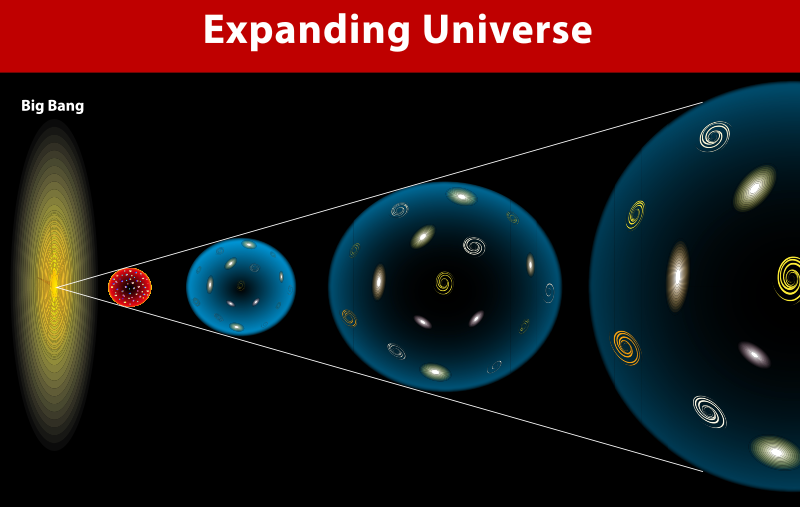Doctor Strange’s latest adventures find him hopping across the multiverse, meeting alternate versions of himself and his enemies as he tries to save not just our universe but every universe. In popular media and our imaginations, Doctor Strange isn’t alone. We surround ourselves with concepts of a multiverse, which present the tantalizing possibility that our reality isn’t the only one.
The multiverse isn’t a creation born from a writer’s notebook, but from a physicist’s chalkboard. Of course, the multiverse found in science is a little bit different than the ones found in movies. There’s a lot less fighting interdimensional demons and a lot more math. But the multiverse of our media owes its existence to a plausible scientific hypothesis. One that’s testable—and has been tested.
Multiverse ideas go back to antiquity, starting with the open question of the possibility of other worlds like our own, scattered throughout the universe (or various conceptions of “the universe”). In modern physics, however, there are only a few distinct places where the notion arises.

To define the multiverse, we first have to define the universe. In the strictest sense, the universe is the limit of all we can ever observe. Our cosmos is only so old, and light can only travel so quickly, so from our vantage point on the Earth we are surrounded by a bubble, roughly 45 billion light-years in radius, that contains all the light that has reached us by the present day.
Outside of that lies … more stuff. More stars and galaxies. Those regions are causally disconnected from us, forever pulled away by the expansion of space itself. This is exacerbated by the presence of dark energy, which accelerates that expansion. We can never see these regions and never access them, and so they represent the most boring but also most uncontroversial version of the multiverse: extensions of “our” universe that just contain more of the same but in different arrangements. This is a generic prediction of the Big Bang model—it’s a simple byproduct of the expansion of the cosmos—but also of literally no observational consequence, and so nobody really argues about it and also nobody really cares. In other words, there’s nothing very special about this kind of “multiverse.”
A second, and potentially more exciting, version of the multiverse comes from quantum mechanics and the “many-worlds” interpretation. In this interpretation, every time that something random happens in the subatomic world (which is a lot), the universe branches off, with the separate universes each containing a realization of one of the random possibilities. In our universe a particle goes left, in another it goes right. However, this multiverse rests on understanding exactly what measurement means in quantum mechanics, which is a very thorny debate. On top of that, physicists aren’t even sure if it’s possible to test this idea—or if the idea has any physical significance at all—and so most physicists do their best to avoid this discussion entirely.
And then we have the multiverse theory born of inflation, which is the most intriguing of them all because it connects to a viable theory of the early universe and provides a route to potential experimental verification. This is the multiverse that just might realize the dreams of our movies and the secret wishes of our hearts. This is the multiverse that we may find evidence for. This is the multiverse that just might be real.
The Many-Branching Universe
Inflation theory traces its origins to theoretical physicist Alan Guth, who developed the earliest version of the concept in a 1981 paper. In an attempt to solve a perplexing riddle of the young cosmos (namely, generic predictions from high-energy physics demanded the existence of a universe riddled with exotic artifacts like magnetic monopoles, and yet none seemed to exist), he proposed that the infant universe underwent a brief period of extremely rapid expansion, known as inflation, thereby flinging all those monopoles beyond the bounds of our observable limit, sweeping them under the cosmological rug.
Inflation also happened to explain other puzzles surrounding the vanilla Big Bang model, like how the universe came to be so uniform throughout its volume in such a relatively brief lifetime. Inflation gave the answer: Once you make a universe go really, really big, you’re left with nothing but homogeneity.
This is the multiverse that just might realize the dreams of our movies.
But the real special sauce behind the theory, and the reason that most cosmologists today believe that something like inflation happened, is that it’s the best story we have for the origin of large structures—the clusters, filaments, and voids that comprise the cosmic web. In inflation theory, when our universe rapidly expanded, the subatomic quantum foam expanded to macroscopic scales, planting the subtle gravitational seeds that would, over the course of hundreds of millions of years, grow into larger stars, galaxies, and more.
Physicists do not know what powered inflation, how long it lasted, or why it shut off, but the predictions that inflation theories make for the statistical properties of large structures match with astounding accuracy what we observe in the universe, and so the idea has held on through the decades.
That last question—Why did inflation shut off?—should stick out a bit. It’s easy to imagine some titanic process igniting in the exotic moments of the early Big Bang. It’s a little bit harder to imagine it just passing quietly into the night, leaving the cosmic stage, never to be seen again.
So perhaps inflation never shut off. Maybe inflation is still happening, just not right here. Indeed, some physicists argue that this is a natural consequence of the randomness inherent in quantum mechanics. All it takes is a little quantum shake, and not all of inflation shuts off simultaneously across the cosmos. Maybe our universe is just one piece of a grander strata that branched off and stabilized into a more sedate phase of growth. Meanwhile, far outside our bubble, inflation continues on and on, with more sections breaking off and stabilizing, leading to other cosmos separated from us in both time and space.
This idea of “eternal inflation” takes the dull concept of just-more-stuff-outside-our-universe and kicks it into overdrive. There isn’t just one universe that happens to be larger than our particular observational limit, but a vast frothing sea of bubbles, each separate universe as gigantic as the next, and each separated by the never-ending expansion of space. Sure, all these branches share a single causal origin—an original Big Bang—but it never stops after that, the number of individual universes quickly reaching infinity.
There’s more. In the original version of this inflation-born multiverse, the bubble universes that sit far outside our own share the same set of physics. The forces of nature out there are the same as the forces in here; the speed of light, for example, holds everywhere across the multiverse.
But when you add string theory to the mix, things really go crazy. String theory started in the 1960s as an attempt to explain the strong nuclear force but grew to become a candidate theory of everything. For decades physicists worked on the concept, hoping to piece together its mathematical puzzles to explain everything. Literally: everything. The forces of nature, the populations of particles and their masses, the values of the physical constants, and even the number of dimensions.
String theory proposes that our cosmos contains additional dimensions, all curled up on themselves at some tiny scale, so we don’t normally see them. The exact way those dimensions curl up determines the physics that we observe, but there are somewhere around 10500 different ways to make the curling happen, and string theory can’t say which one should correspond to our particular universe.
When you combine this string theory “landscape” with eternal inflation, you get a chance to realize all possible configurations of the curled-up dimensions—the mechanism of the inflation populates the cosmos with universes that have all sorts of different physics. Our universe could have looked completely different, with different physical constants and even entirely different forces of nature, if our inflation had generated a different configuration of the curled-up dimensions in string theory. And if inflation never ends, perhaps different bubble universes have different physics, different laws, different constants, and even different realities.
This is the ultimate multiverse, potentially capable of solving some deep issues in physics and cosmology.
For example, with the opening of the century, physicists clamored for an explanation of dark energy, the accelerated expansion of the universe. One of the strangest things about dark energy is that it’s incredibly weak—giving rise to only a subtle acceleration—but not exactly zero. It seems incredibly fine-tuned; if it had even a slightly different value, life would be impossible.
The string-motivated multiverse offers one way to navigate this predicament. In a variety of universes that realize every possible strength of dark energy, we happen to find ourselves in this one because we simply couldn’t exist in any other.
Chance Encounters
It’s the observational consequences of all these multiverse concepts that make them so interesting. Otherwise they would just be the idle fantasies of bored tenured physicists.
There are some limited ways to test the inflation-driven multiverse idea. For example, if a nearby universe pinched off soon after the formation of ours, it might briefly collide with ours before racing away. The likelihood of that happening in the present-day universe is vanishingly small, because inflation drives expansion so rapidly (superluminally, in fact) and it’s been almost 14 billion years since our Big Bang, so any other universes are well and far away from us.
But if a neighbor universe formed early enough and quickly enough, it could have bumped into ours when it was still an infant. That brief intersection would leave behind a detectable imprint in the cosmic microwave background, the afterglow light pattern formed when our universe transitioned from a plasma to neutral state when it was 380,000 years old. This light pattern is the most distant thing we can directly observe, and so it’s our best chance of observing this kind of encounter.
We happen to find ourselves in this universe because we couldn’t exist in any other.
That is a testable, bona-fide scientific prediction. Alas, searches for such signals have consistently turned up empty. But that lack of a signal doesn’t rule out the entire multiverse, just the limited case of the scenario where one universe intersects with ours.
Lacking any direct experimental options, we have to take an indirect route. We can poke at theories and models of inflation, attempting to determine if the multiverse is a generic, automatic outgrowth of all inflation models, the most physically viable and/or simplest ones, only a handful, or none at all. Unfortunately, inflation theory rests on understanding ultra-high-energy physics, and at these scales we remain relatively ignorant—there’s no clear indication that for every inflation theory, you get a multiverse theory.
We can also put inflation itself to the test. If observations teach us about which inflation model or scenario is correct, then we can ask if that specific case—the case that applies to our universe—generates a multiverse. We can’t directly observe inflation, because it happened way too early, but we can observe its effects, especially through the cosmic microwave background. When astronomers first measured tiny fluctuations in that light with the NASA Cosmic Background Explorer satellite in the 1990s, inflation theory was the only one to make a correct prediction of their statistical properties. Unfortunately, those same observations—and many follow-up missions—haven’t told us which of the many varied inflation models is the best, let alone provided a slam-dunk, case-closed, argument-over proof of inflation itself.
Still, future observations may provide a breakthrough. Inflation should have left behind ripples in spacetime known as gravitational waves. We’ve already observed some gravitational waves from merging compact objects with LIGO (Laser Interferometer Gravitational-Wave Observatory), but those instruments will not be able to detect the low-frequency waves created during inflation. So plans are underway to find the waves directly with space-born instruments like LISA (Laser Interferometer Space Antenna) or indirectly through their subtle imprint in the cosmic microwave background. Only time will tell if those efforts bear fruit and lead us to a confirmation (or rejection) of inflation.
But even if we could do that—demonstrate that inflation theory is the only viable explanation for the processes occurring in the early universe and mathematically show that the multiverse is an organic extension of that model—it still wouldn’t be evidence for the existence of the multiverse.
Sure, we can test a theory in one domain that we can easily access (say, general relativity in the solar system) and extend that to guess at what happens in other domains that we can’t access based on mathematical consistency and the universality of physics (say, what happens inside a black hole), but that can only take us so far. Indeed, for this example, we know that general relativity breaks down in the singularity of a black hole, so even though we can’t ever access the inside of one (without diving beneath the event horizon ourselves), we are still aware that the theory has its limits.
Unfortunately, we don’t know if the multiverse exists, and we may never know.
Persistence of the Many
Despite an initial surge of interest in the topic of the multiverse in the beginning of the 21st century, both theoretical and observational work on the multiverse has stalled out in the past decade. Some of that is just due to the nature of the beast: It takes time to plan, deploy, and run the massive observatories needed to probe the early universe. But some of the decaying interest is caused by the fact that the concept of the multiverse hasn’t given us much clarity.
The best argument behind the multiverse is that it provides a potential way for explaining why our universe has the fundamental properties that it does: because other configurations of forces and masses and constants would render our cosmos inhospitable, and so we wouldn’t be here. This is known as the anthropic argument, which proponents say is a viable path to understanding reality.
We create an alternate reality every time we open a book or watch a movie.
But critics point out several flaws. Do we really want to rest our scientific arguments on such logical dead-ends? Are all the realizations of the multiverse actually capable of generating different physics? Is our particular configuration rare or common, and how do we actually measure that in a span of infinite individual universes without weighing down the argument with so many assumptions that the theory loses all meaning?
String theory, which is required for the multiverse to generate different bubbles with their own sets of physical laws, has its own troubles. String theorists have yet to find a solution—any solution. Even though we now know that the way the extra dimensions curl up on themselves determines the physics we experience, we don’t know how that works. If you gave a string theorist a particular configuration of extra dimensions, they couldn’t tell you the physics that it produces. Plus, many versions of string theory rest on the concept of supersymmetry, which now looks sketchy, as the Large Hadron Collider has failed to find any evidence for it.
The multiverse isn’t dead, but like all ideas in science that seem promising at first but don’t yield much observational fruit or even theoretical inspiration, it’s dying. Physicists don’t pay much attention to the multiverse anymore, and the arguments for its existence haven’t advanced much since it was originally proposed decades ago. Most of the arguments for the multiverse lay within the realm of unknown physics.
And yet the concept of the multiverse persists. In an infinity of universes, everything that can happen will happen. There is a universe out there where you asked out your crush, or took that job offer, or said goodbye to your parent before they passed. And it’s not in some imaginary land or “parallel” (whatever that means) reality. All these other pinched-off bubble universes occupy the great expanse of the volume of the multiverse. They exist within the same domain of spacetime as we do.
They’re incredibly far away, but still a finite distance. You can point your finger in any random direction on the sky, and if you followed that line long enough, you would encounter a universe where a version of you is doing the exact same thing, pointing back at you. With an infinity of universes, all the branching possibilities of your life, and everybody else’s life, and all the potential interactions of stars and galaxies and hydrogen molecules, and maybe even all the different combinations of forces of nature and physical constants, are real.
Of course it would be awesome if the multiverse were real. The temptation is too great to ignore. We create an alternate reality every time we open a book or watch a movie: Every work of fiction is itself a realization of a multiverse, where the rules of that fictional universe are similar to—but slightly different from—the one we inhabit. In the multiverse, our dreams literally come true, especially if those alternate pinched-off universes contain different laws of physics. You want to fly? There’s a version of you out there, somewhere, doing that right now. You want to consume stars for breakfast? That too. You want magic? Sure, why not.
The multiverse turns our fantasies into reality. Inaccessible, forever distant, but real, nonetheless. And so even if the concept fades from the focus of scientific inquiry, we’ll keep dreaming about it. Which isn’t a bad thing: Science advances one dream at a time. ![]()
Paul M. Sutter is a research professor in astrophysics at the Institute for Advanced Computational Science at Stony Brook University and a guest researcher at the Flatiron Institute in New York City. He is the author of Your Place in the Universe: Understanding our Big, Messy Existence.
Lead photo: Marvel


























